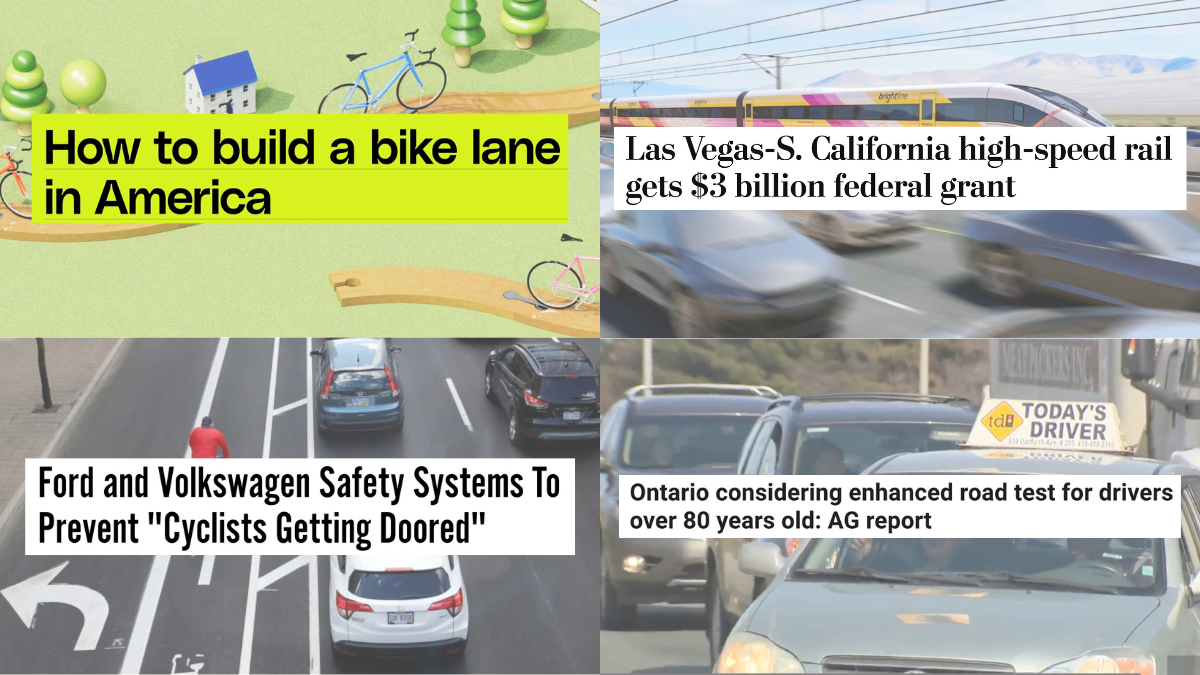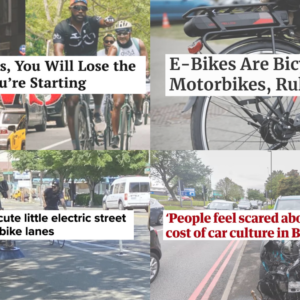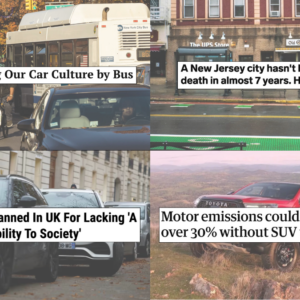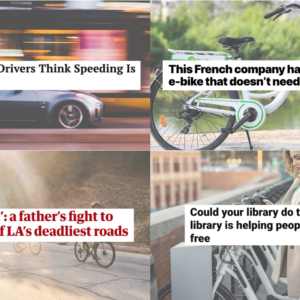Darkness and deaths: Portland is highlighted in this important article that explains why America has an exceptionally high number of pedestrian traffic deaths. There are some factors highlighted here — like how shift workers have moved into places with more dangerous roads — that I hadn’t considered before. (NY Times)
Where separation is mandatory: Cambridge (MA) passed a council ordinance that required protected bike lanes whenever a road is reconstructed and the results have been very positive. (Velo)
Why ‘shared space’ doesn’t work: The idea of ‘shared space’ pushed by Hans Monderman was supposed to usher in a new era of street civility and socialized public space; but it hasn’t quite turned out that way. (Global Cycling Network)
The state of the art: A deep dive into the challenges of building bike infrastructure in America, with mention of the protested bike lane removal on NE 33rd Ave in Portland. (The Verge)
Parking policy follies: Turns out some cities determine mandatory parking ratios with scant research, even though the decisions can have vast impacts on whether or not housing gets built. (Sightline)
Sensible reforms: In Ontario, Canada, policymakers are considering more stringent driving tests for older drivers and additional driver’s training for people who receive citations for stunt driving. (Global News CA)
HSR breakthrough: The US DOT has awarded a $3 billion grant to a private company to build high-speed rail between Southern California and Las Vegas. Let’s f’ing go! (Washington Post)
Chugging along: Meanwhile, the dream of Cascadia HSR won a paltry $1 million in planning grants from the same pot of funding. (The Urbanist)
Cycling at COP28: Learn about the sole cycling group that participating in the climate talks in Dubai over the past week or so. (Forbes)
Daylighting intersections: Moving parked cars away from corners with a mix of barricades and enforcement seems like one of the easiest ways to improve street safety. I’m sharing this link in hopes folks at PBOT will read it and remember their promise to daylight 350 Portland intersections! (Streetsblog NYC)
Portland influencers: A widely read list of the 50 most influential people in American cycling includes two Portlanders: bike bus leader Sam Balto and transgender rights activist Molly Cameron. (Escape Collective)
E-bike license push: There’s growing momentum in New York City to require licenses and registration for e-bike riders. Let’s hope no one outside the Big Apple thinks this is a good policy direction. (Gothamist)
‘Exit warnings’: Interesting safety news from Ford and Volkswagen as they are set to debut new tech that will warn drivers if there’s a bicycle rider approaching before they swing open their door. (Men’s Journal)
Thanks to everyone who sent in links this week. The Monday Roundup is a community effort, so please feel free to send us any great stories you come across.







Thanks for reading.
BikePortland has served this community with independent community journalism since 2005. We rely on subscriptions from readers like you to survive. Your financial support is vital in keeping this valuable resource alive and well.
Please subscribe today to strengthen and expand our work.
Brightline West is an interesting project, but it’s lack of good end stations is frustrating. Las Vegas to LA sounds good, but the projects terminii are actually Enterprise CDP (unincorporated Clark County just south of the Vegas Airport) to Rancho Cucamongo in San Bernardino County (35 miles east of LA). Though Rancho Cucamongo is on Metrolink’s San Bernardino line, I have doubts that will mean through running trains to LA Union Station.
Although it will be sort of funny if the second HSR corridor (yes, the northeast corridor has HSR already!) links Enterpise, NV to Rancho Cucamongo.
Even funnier is how an average speed of 86 mph is now thought of as “HSR”, at least for the feds. I was reading earlier today about similar projects funded with the same bill in the Southeastern Corridor, including a $1 billion line between Raleigh & Richmond, as well as reviving a long-abandoned line NYC to Scranton PA (where Biden was born).
Keep lowering the bar until you achieve success!
HSR is typically defined by max speed, rather than operating speed. And sure there are tons of ways that we should pursue reducing operating speeds on the NEC, but that doesn’t mean the portions between NYC and Philly or in Rhode Island that operate at 150 MPH aren’t HSR.
Id say all the projects identified for funding are good, but the Lackawanna cut-off to Scranton may be my personal favorite. It’s a great example of an early high speed line, and Conrail abandoning it was a huge mistake.
Personally, I define HSR as anything over 300 kmh (about 200 mph) on ultra smooth track, such as on the French TGV or German ICE, which I’ve experienced many times. This summer I took the NEC line from Washington DC to New Haven CT on an older standard Regional trainset (not Acela), and while it was fairly fast, it was far from smooth. On one of my train trips, in New Jersey, someone had an app that recorded real-time speed – we got up to 115 mph at one point.
The Biden White House issued a series of press releases that these articles cited, clearly touting the projects when they passed through electoral “swing states” like Virginia, PA, NC, Georgia, and Nevada, states that right now have Democratic governors and/or legislatures but are often Republican or states that often vote Republican for president. South Carolina will benefit hugely from any of these projects that connect DC to Atlanta or Florida, but to Democrats it’s a lost cause, so no PR. And of course California, Oregon, and Washington always vote Democrat anyway, so why push it?
I’ve met a surprising number of otherwise quite intelligent people here in NC who think that when I say “Vancouver BC” that what I meant was some obscure subway stop in DC.
Your definition is a bit more stringent than the generally accepted norm of 200 kph for upgraded lines to 250 kph for new lines (125 to 155 mph). And not to belabor the point, but Germany has relatively little few high speed lines especially compared to France, Italy, and Japan with most ICE trains running on tracks that are probably best compared to the NEC. Though they do have a handful of 300 kph lines, most notably from Cologne to Frankfurt.
And generally speaking the Acela reaches higher speeds than the Regionals because of the trains themselves, which hopefully are due for replacement soon. I think I hit 120 on Keystone Service train to NYC last year.
CityNerd posted a good video on that problem recently: https://www.youtube.com/watch?v=11Noo855zyA
Good video. It was interesting that while he considered transit wherever possible, he always concluded “better to drive to the airport/train station”.
Can’t believe you called out the LA-LV Brightline federal grant but didn’t notice Cascadia HSR being included in the same round of funding! Very good news all around!
yeah I left that out. Just added it. Thanks.
I’m not in the Big Apple, and I think licensing, insurance, and registration (with enforcement!) for mopeds is a good idea. Better than the status quo, at least.
As long as there is a clear distinction between mopeds and e-bikes, I’m with you.
There is: mopeds are low powered motorcycles capable of 30 mph, while e-bikes are motor-assisted bicycles capable of 30 mph.
Deleted
Time and time again, comparisons between ebikes and motorcycles or mopeds comes up here on BP, and each time, people seem to forget that the average weights between them are very different. Ebikes, while dangerous in their own way, present different risk given their lower weights.
I agree with your fundamental point, but bikes themselves have higher and lower weights, and a fully loaded cargo bike hitting you at 30mph will pack a lot more oomph than a moped.
Just because one is categorized as a “bicycle” and another as a “moped” is not sufficient information to determine which is more dangerous.
From the NYC intersection daylighting article:
“State law already bans parking within 20 feet of crosswalks, but the city has long exempted itself from that rule in favor of more private car storage…”
Sounds frustratingly familiar.
Darkness and deaths: Can’t read it due to site paywall.
Where separation is mandatory: Also a paywall.
HSR breakthrough: Another paywall.
Cycling at COP28: Surprise! It’s a paywall.
Most of these sites do not have genuine paywalls but rather have web-filters that hide content for those who don’t create an account. The “bypass paywalls clean” extension wipes away nag layers on chrome, firefox, and android (kiwi browser or firefox collections):
https://gitlab.com/magnolia1234/bypass-paywalls-firefox-clean
https://gitlab.com/magnolia1234/bypass-paywalls-chrome-clean
Journalism is apparently the process of monetizing information from free government sources and public propaganda, at least for all 4 of these stories.
Hi Johnny Bye Carter,
I’m not sure what your point is with this comment. Are you saying you don’t want to pay for that content? That’s your choice of course. I just don’t understand why you would be surprised that businesses charge for their services. These stories don’t just appear out of thin air. Do you get mad when you go to the coffee shop and have to pay for your drink?
Wait… I’m supposed to pay??? That explains a lot.